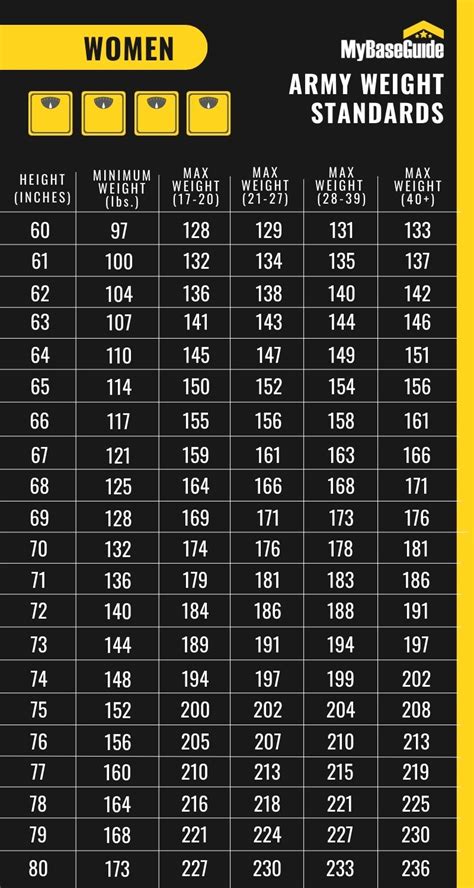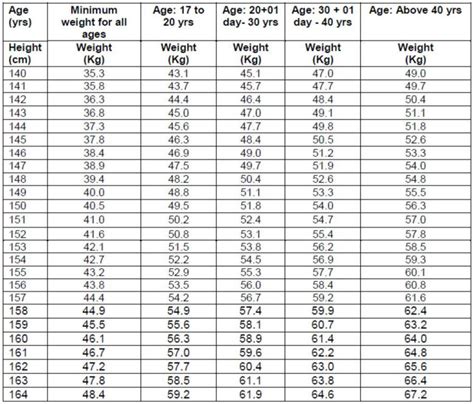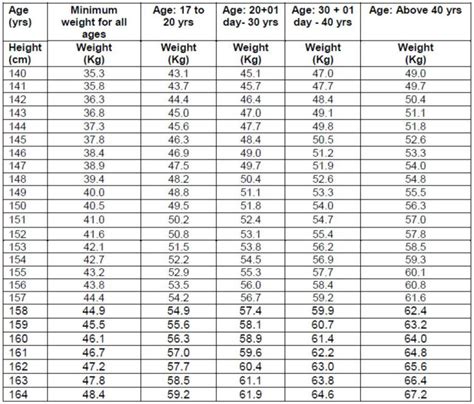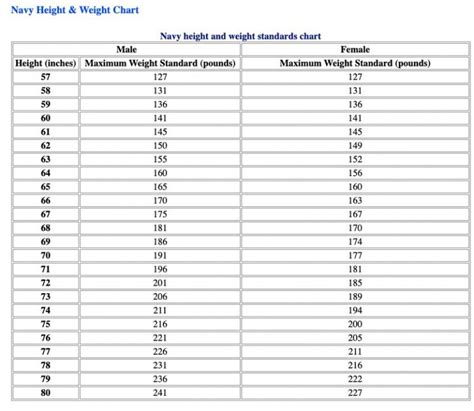Army Weight Standards 2024

Maintaining physical fitness is an integral part of military life, and one of the key aspects of this is meeting the army weight standards. These standards ensure that soldiers are physically capable and ready for the demands of their roles. In this blog post, we will delve into the details of the Army Weight Standards for 2024, providing an in-depth guide to help you understand and meet these requirements.
Understanding Army Weight Standards

The Army Weight Standards, also known as the Body Composition Program, are designed to assess and maintain the physical readiness of soldiers. It is a crucial component of the overall fitness evaluation, alongside other factors like physical fitness tests and medical assessments.
These standards are based on the Body Mass Index (BMI), which is a measure of body fat based on height and weight. By setting specific BMI ranges, the Army ensures that its soldiers are within a healthy weight range, capable of performing their duties effectively.
The BMI ranges are divided into two categories: desirable and overweight. Soldiers are expected to fall within the desirable range, which promotes overall health and minimizes the risk of injury or fatigue during training and operations.
2024 Army Weight Standards: What You Need to Know

The Army Weight Standards for 2024 remain consistent with previous years, focusing on maintaining a healthy BMI. Here's a breakdown of the key aspects:
Body Mass Index (BMI) Calculation
BMI is calculated using the following formula:
BMI = Weight (kg) / Height (m2)
For example, if a soldier weighs 70 kg and is 1.75 meters tall, their BMI would be calculated as follows:
BMI = 70 kg / (1.75 m x 1.75 m) = 22.86
Desirable BMI Range
The desirable BMI range for soldiers is 18.5 to 25. This range is considered healthy and ensures that soldiers are physically fit and capable of performing their duties without excessive strain on their bodies.
Overweight BMI Range
Soldiers with a BMI of 26 or higher are considered overweight. While this does not automatically disqualify them from service, it indicates the need for weight management and physical fitness improvement.
Height and Weight Standards
The Army provides specific height and weight standards for male and female soldiers. These standards are based on age groups and are designed to ensure a healthy body composition. Here's a simplified table outlining the standards:
| Age Group | Male Height (cm) | Male Weight (kg) | Female Height (cm) | Female Weight (kg) |
|---|---|---|---|---|
| 17-20 | 152.4-193.0 | 54.4-90.7 | 152.4-177.8 | 45.3-72.5 |
| 21-27 | 152.4-193.0 | 54.4-90.7 | 152.4-177.8 | 45.3-72.5 |
| 28-40 | 152.4-193.0 | 54.4-90.7 | 152.4-177.8 | 45.3-72.5 |
| 41-60 | 152.4-193.0 | 54.4-90.7 | 152.4-177.8 | 45.3-72.5 |

Meeting the Army Weight Standards

If you're aiming to meet the Army Weight Standards, here are some key steps to consider:
- Assess Your BMI: Calculate your BMI using the formula provided. If you fall within the desirable range, maintain a healthy lifestyle and continue your physical fitness regimen.
- Consult a Professional: If you are overweight or approaching the overweight BMI range, consult a healthcare professional or a military fitness trainer. They can provide personalized guidance and a plan to help you achieve your weight management goals.
- Nutrition and Diet: Focus on a balanced and nutritious diet. Aim for a calorie deficit if you need to lose weight, and consult a registered dietitian for a customized meal plan.
- Physical Activity: Engage in regular physical activity, including cardiovascular exercises and strength training. Incorporate high-intensity interval training (HIIT) and resistance exercises to boost your metabolism and build muscle.
- Stay Consistent: Consistency is key. Stick to your fitness and nutrition plan, and track your progress regularly. Celebrate your achievements and stay motivated.
Tips for Maintaining a Healthy Weight

Here are some additional tips to help you maintain a healthy weight and meet the Army Weight Standards:
- Set Realistic Goals: Set achievable weight loss or maintenance goals. Aim for a steady and sustainable progress rather than rapid weight loss.
- Stay Hydrated: Drink plenty of water throughout the day. Staying hydrated can help control your appetite and boost your metabolism.
- Manage Portion Sizes: Be mindful of your portion sizes during meals. Avoid overeating, and listen to your body's hunger and fullness cues.
- Incorporate Variety: Include a variety of foods in your diet, focusing on whole, unprocessed foods. This ensures you get a wide range of nutrients and keeps your diet interesting.
- Meal Planning: Plan your meals in advance to ensure you have healthy options readily available. This can help prevent unhealthy food choices due to convenience.
Common Challenges and Solutions

Meeting the Army Weight Standards can present some challenges. Here are some common issues and potential solutions:
- Time Constraints: If you have a busy schedule, find creative ways to fit in physical activity. Short, intense workouts can be just as effective as longer sessions. Consider joining a military fitness group or utilizing online resources for guidance.
- Nutrition on the Go: When you're on the move, it can be challenging to maintain a healthy diet. Pack nutritious snacks and meals to ensure you have healthy options readily available.
- Injuries and Setbacks: Injuries or unexpected setbacks can hinder your progress. Seek medical advice and follow a rehabilitation plan if needed. Modify your workouts to accommodate any injuries, and focus on maintaining a healthy weight during your recovery.
- Motivation and Support: Surround yourself with a supportive community. Join military fitness groups or find a workout buddy to keep you motivated. Share your progress and challenges with others, and celebrate your successes together.
💡 Note: Remember, meeting the Army Weight Standards is not just about looking a certain way; it's about ensuring your physical readiness and overall health. Focus on a holistic approach to fitness and well-being.
Conclusion

The Army Weight Standards for 2024 emphasize the importance of maintaining a healthy BMI and body composition. By understanding these standards and taking proactive steps towards weight management, soldiers can ensure they are physically prepared for the challenges of military service. Remember, a healthy weight is not just a requirement; it's a foundation for overall well-being and mission readiness.
FAQ

What happens if I exceed the overweight BMI range?
+If your BMI exceeds the overweight range, you may be required to participate in a weight management program. This program provides guidance and support to help you achieve a healthy weight. It’s important to take action and work towards meeting the standards.
Are there any exceptions to the Army Weight Standards?
+While the Army Weight Standards are generally applicable to all soldiers, there may be certain medical conditions or circumstances that require an exception. These cases are evaluated on an individual basis by military healthcare professionals.
How often are soldiers evaluated for their weight and BMI?
+Soldiers are typically evaluated for their weight and BMI during their annual physical fitness assessments. However, additional evaluations may be conducted if there are concerns about an individual’s weight or overall fitness level.
Can I use a BMI calculator instead of manually calculating my BMI?
+Yes, there are many reliable BMI calculators available online. These calculators can provide a quick and convenient way to estimate your BMI. However, it’s important to understand the underlying formula and how BMI is calculated to ensure accuracy.
